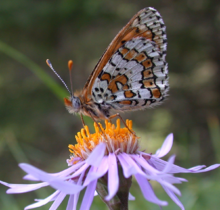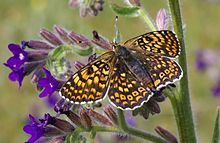- Glanville Fritillary
-
Glanville Fritillary 
Scientific classification Kingdom: Animalia Phylum: Arthropoda Class: Insecta Order: Lepidoptera Family: Nymphalidae Genus: Melitaea Species: M. cinxia Binomial name Melitaea cinxia
(Linnaeus, 1758)The Glanville Fritillary (Melitaea cinxia) is a butterfly of the Nymphalidae family.
The animal spends most of its life as a black, spiny caterpillar. The orange patterned butterfly lives only a few weeks.
The Glanville Fritillary inhabits open grassland throughout Europe (except much of Great Britain, Scandinavia, and southern Spain) and temperate Asia. A subspecies inhabits North Africa. Severe population declines are reported in many European countries.
Contents
Life cycle
The Glanville Fritillary (Melitaea cinxia) is a medium sized orange, black and white "checkerspot" butterfly inhabiting open meadows. The males patrol along roads and habitat edges, on the lookout for the less conspicuous females which remain in dense tussocks for long periods. Mating occurs around mid-day, and as the female often continues to fly from flower to flower, mating pairs are conspicuous.
Throughout most of their range they have one generation per year, overwintering as larvae. In warm regions they have two generations per year. In her lifetime, a female lays several clusters of up to 200 eggs on the underside of the larval food plant. She feeds on nectar (with her proboscis) from surrounding flowering plants. The larvae feed on several species of plants in the genera Plantago and Veronica. They live in gregarious family groups in characteristic silken webs ("nests") throughout most of their larval stage. When alarmed, a feeding group of Glanville Fritillary larvae will jerk their heads in unison, probably to distract their enemies.
Through the winter (or summer where it is very dry), the caterpillars stop feeding and lie dormant until spring (or fall, where the summer is dry) when they resume eating, and eventually pupate. The inconspicuous pupa hangs from a plant stem or lies in the leaf litter for 2 to 3 weeks, until the next generation of adults emerges, living for only up to three weeks.
Glanville Fritillaries in the UK
In the UK the Glanville Fritillary occurs only on soft undercliff and chine grassland and the slopes above where its main larval foodplant Plantago lanceolata occurs in abundance on sheltered, south facing slopes. The Glanville Fritillary is a highly restricted species in the UK being confined to the south coast of the Isle of Wight. It also occurs in the Channel Islands and since 1990 there has been a mainland site on the Hampshire coast, possibly an introduction. There are small introduced populations on the Somerset coast and near Wrecclesham in Surrey.
Historic UK records suggest a distribution which went as far north as Lincolnshire. However, by the middle of the 19th century the Glanville Fritillary was known only from the Isle of Wight and the coast of Kent between Folkestone and Sandwich. It became extinct in Kent by the mid 1860s.
Origin of Name
The Glanville Fritillary is named for Lady Eleanor Glanville, an eccentric 17th and 18th century English butterfly enthusiast – a very unusual occupation for a woman at that time. She was the first to capture British specimens in Lincolnshire during the 1690s. A contemporary wrote:
This fly took its name from the ingenious Lady Glanvil, whose memory had like to have suffered for her curiosity. Some relations that was disappointed by her Will, attempted to let it aside by Acts of Lunacy, for they suggested that none but those who were deprived of their senses, would go in Pursuit of butterflies. Moses Harris, 1776
External links
Categories:- Melitaea
- Environment of the Isle of Wight
- Butterflies and moths of Europe
- British butterflies
- Animals described in 1758
Wikimedia Foundation. 2010.

